- This is what I wrote during the exam.
- We did Section 7.1 today. I proved Theorem 1 (essentially the same proof as in the book) and I proved that all eigenvalues of a symmetric matrix are real. In the book this proof is in Exercise 24 in Section 5.5. Each of these proofs might appear on the final.
- Suggested problems for Section 7.1: 3, 4, 9, 11, 15, 19, 23, 24, 25, 27, 30, 31, 32, 33, 35, 36, 37
- Suggested problems for Section 7.2: 1, 3, 5, 7, 9, 13, 17, 19, 21, 23, 25
- Suggested problems for Section 7.3: 1, 3, 5, 9, 11, 12
- Suggested problems for Section 7.4: 3, 7, 11, 13, 14, 15, 17, 21
- Suggested problems for Section 6.7: 1, 2, 3, 5, 7, 9, 10, 13, 16, 17, 19, 20, 21, 23, 25
- Suggested problems for Section 6.8: 1, 2, 5, 6, 7, 9, 10, 11, 14
- This is what I wrote during the exam.
- Suggested problems for Section 6.5: 1, 3, 6, 7, 9, 13, 16, 17, 19, 20, 21, 22
- Suggested problems for Section 6.6: 3, 4, 8, 9, 14, 15, 16
- Suggested problems for Section 6.1: 1, 5, 7, 8, 9-12, 13, 15-18, 20, 22, 24, 25, 26, 27, 28, 29, 31
- Suggested problems for Section 6.2: 2, 3, 5, 8, 9, 11, 13, 15, 17, 19, 21, 23, 25, 26, 27, 29
- Suggested problems for Section 6.3: 1, 2, 4, 5, 7, 10, 11, 13, 15, 16 17, 19, 20, 21, 23
- Suggested problems for Section 6.4: 2, 3, 5, 7, 9, 13, 15, 17, 19, 20
- Suggested problems for Section 5.6: 3, 4, 5, 6, 9, 12, 13, 15
- This is what I wrote during the exam.
- Suggested problems for Section 5.5: 1-6 (Are these matrices in my "The book of Beautiful Matrices"?), 7-12, 13, 16, 17, 18, 21, 25, 26
- The Book of Beautiful Matrices consists of two-by-two matrices whose entries and eigenvalues are integers between -9 and 9. I consider only the matrices with the nonnegative top-left entry. In addition, I consider only matrices with the relatively prime entries. To get matrices that are omitted in this way you just multiply one of the given matrices by an integer. You need to adjust the eigenvalues by multiplying them with the same integer. The eigenvectors remain unchanged.
- I divided the Book in three volumes: Volume 1 contains matrices with real distinct eigenvalues, Volume 2 contains matrices with non-real eigenvalues (whose real and imaginary part are integers between -9 and 9) and Volume 3 contains matrices with a repeated eigenvalue. The eigenvalues and a corresponding eigenvector (and a root vector for repeated eigenvalues) are given for each matrix. Three volumes in pdf format are here:
- Suggested problems for Section 5.4: 1, 3 - 13, 17, 19 - 23, 27, 28
- This is the Mathematica file that I used today. It is called Diagonal.nb. Right-click on the underlined word "This"; in the pop-up menu that appears, your browser will offer you to save the file in your directory. Make sure that you save it with the exactly same name. After saving the file you can open it with Mathematica. Follow the instructions from June 24.
- More information on how to use Mathematica you can find on my Mathematica page.
- Suggested problems for Section 5.3: 1, 3, 5, 6, 7, 8, 15, 17, 18, 21, 22, 23, 26, 27, 28, 31
- Suggested problems for Section 5.2: 1-8 (find corresponding eigenvectors as well), 9, 13, 15, 18, 19, 20, 21, 24, 25, 27
-
Today in class I demonstrated how to use Mathematica to calculate eigenvalues and eigenvectors. Here is the Mathematica file that I used. It is called Matrix.nb. Right-click on the underlined word "Here"; in the pop-up menu that appears, your browser will offer you to save the file in your directory. Make sure that you save it with the exactly same name. After saving the file you can open it with Mathematica. You need to find a campus computer with Mathematica installed on it (for example BH 209, BH 215). You will find Mathematica as follows (this sequence might differ on different campus computers)
Start -> Programs -> Math Applications -> Mathematica. Open Mathematica first, then open Matrix.nb from Mathematica. You can execute the entire file by the following manu sequence (in Mathematica):Kernel -> Evaluation -> Evaluate Notebook. There are some more instructions in the file. - More information on how to use Mathematica you can find on my Mathematica page.
- If you have problems running files that I posted please let me know. If you spend some time learning how to use Mathematica you will enhance your understanding of math that we are studying.
- A related Wikipedia link: Characteristic polynomial. Wikipedia's presentation is slightly different from ours.
- The information sheet
- Suggested problems for Section 5.1: 1, 3, 4, 5, 6, 8, 11, 15, 16, 17, 19, 20, 24-27, 29, 30, 31
- A related Wikipedia link: Eigenvalue, eigenvector and eigenspace.
- Here are animations of different matrices in action. In each scene the navy blue vector is the image of sea green vector under multiplication by a matrix A. For easier visualization of the action the heads of the vectors leave traces. Just looking at the movies you can guess what the matrix is in each movie. You can also see what its eigenvalues and eigenvectors are, whether they are positive, negative, complex, ...
Place the cursor over the image to start the animation.
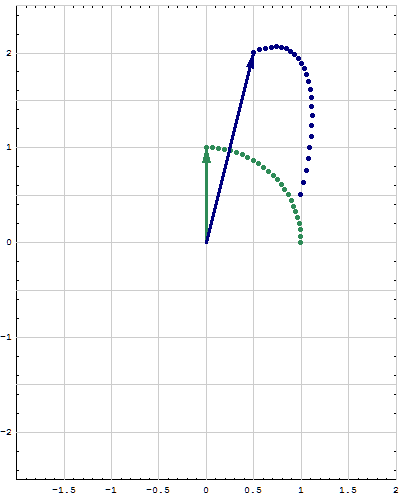
|
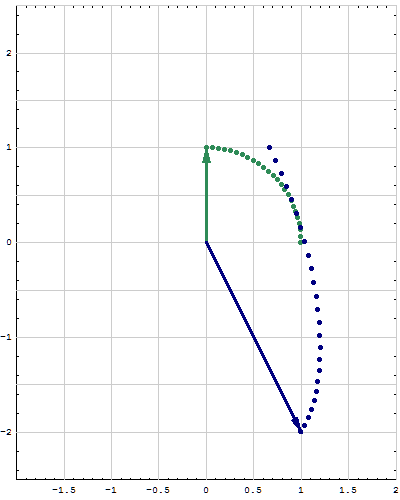
|

|
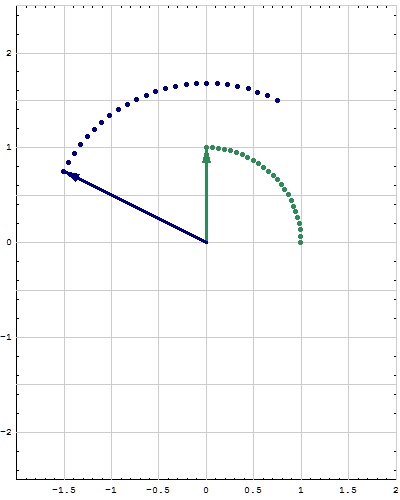
|
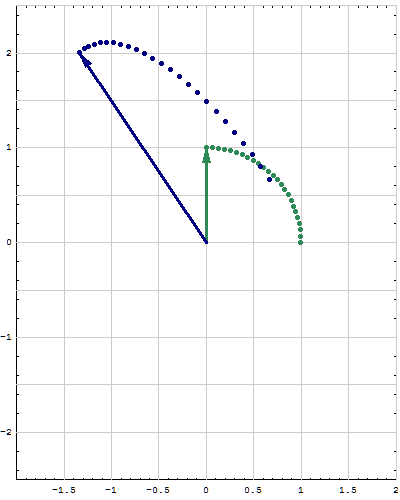
|
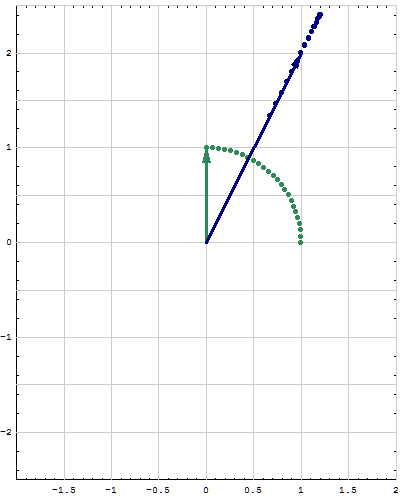
|
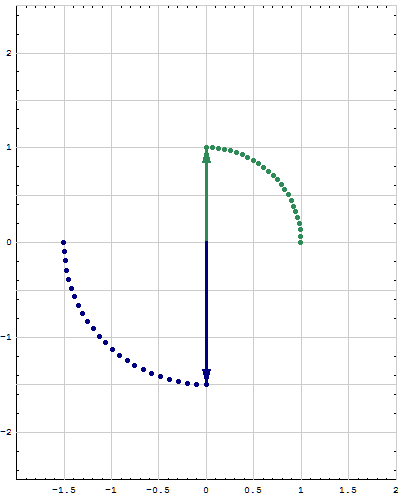
|
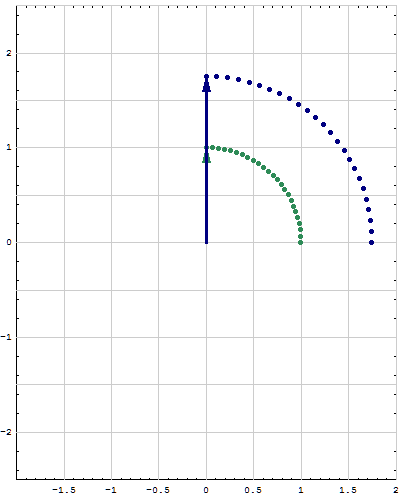
|